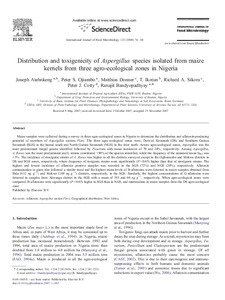| dc.contributor.author | Atehnkeng, J. |
| dc.contributor.author | Ojiambo, P. |
| dc.contributor.author | Donner, M. |
| dc.contributor.author | Ikotun, T. |
| dc.contributor.author | Sikora, R.A. |
| dc.contributor.author | Cotty, P. |
| dc.contributor.author | Bandyopadhyay, Ranajit |
| dc.date.accessioned | 2019-12-04T11:14:37Z |
| dc.date.available | 2019-12-04T11:14:37Z |
| dc.date.issued | 2008 |
| dc.identifier.citation | Atehnkeng, J., Ojiambo, P., Donner, M., Ikotun, T., Sikora, R., Cotty, P. & Bandyopadhyay, R. (2008). Distribution and toxigenicity of Aspergillus species isolated from maize kernels from three agro-ecological zones in Nigeria. International Journal of Food Microbiology, 122(1), 74-84. |
| dc.identifier.issn | 0168-1605 |
| dc.identifier.uri | https://hdl.handle.net/20.500.12478/2812 |
| dc.description.abstract | Maize samples were collected during a survey in three agro-ecological zones in Nigeria to determine the distribution and aflatoxin-producing potential of members of Aspergillus section Flavi. The three agro-ecological zones were, Derived Savannah (DS) and Southern Guinea Savannah (SGS) in the humid south and North Guinea Savannah (NGS) in the drier north. Across agro-ecological zones, Aspergillus was the most predominant fungal genera identified followed by Fusarium with mean incidences of 70 and 24%, respectively. Among Aspergillus, A. flavus was the most predominant and L-strains constituted > 90% of the species identified, while the frequency of the unnamed taxon SBG was < 3%. The incidence of atoxigenic strains of A. flavus was higher in all the districts surveyed except in the Ogbomosho and Mokwa districts in DS and SGS zones, respectively, where frequency of toxigenic strains were significantly (P < 0.05) higher than that of atoxigenic strains. The highest and lowest incidence of aflatoxin positive samples was recorded in the SGS (72%) and NGS (20%), respectively. Aflatoxin contamination in grain also followed a similar trend and the highest mean levels of B-aflatoxins were detected in maize samples obtained from Bida (612 ng g− 1) and Mokwa (169 ng g− 1) districts, respectively, in the SGS. Similarly, the highest concentrations of G-aflatoxins were detected in samples from Akwanga district in the SGS with a mean of 193 and 60 ng g− 1, respectively. When agro-ecological zones were compared, B-aflatoxins were significantly (P < 0.05) higher in SGS than in NGS, and intermediate in maize samples from the DS agro-ecological zone. |
| dc.description.sponsorship | Federal Ministry for Economic Cooperation and Development, Germany |
| dc.language.iso | en |
| dc.subject | Aflatoxins |
| dc.subject | Aspergillus Section Flavi |
| dc.subject | Geographical Distribution |
| dc.title | Distribution and toxigenicity of Aspergillus species isolated from maize kernels from three agroecological zones in Nigeria |
| dc.type | Journal Article |
| dc.description.version | Peer Review |
| cg.contributor.affiliation | International Institute of Tropical Agriculture |
| cg.contributor.affiliation | University of Ibadan |
| cg.contributor.affiliation | University of Bonn |
| cg.contributor.affiliation | University of Arizona |
| cg.coverage.region | Africa |
| cg.coverage.region | West Africa |
| cg.coverage.country | Nigeria |
| cg.isijournal | ISI Journal |
| cg.authorship.types | CGIAR and developing country institute |
| cg.iitasubject | Aflatoxin |
| cg.iitasubject | Maize |
| cg.iitasubject | Pests Of Plants |
| cg.iitasubject | Plant Diseases |
| cg.iitasubject | Disease Control |
| cg.accessibilitystatus | Limited Access |
| local.dspaceid | 93913 |

